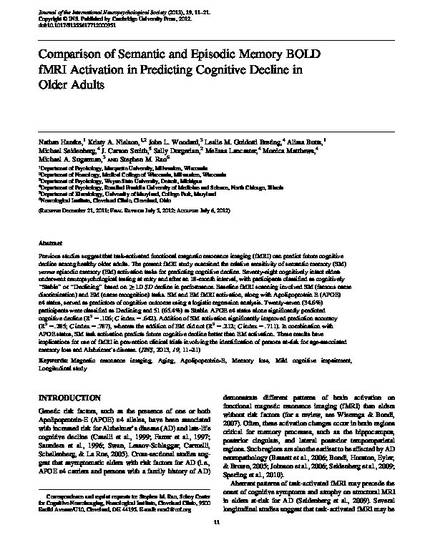
Previous studies suggest that task-activated functional magnetic resonance imaging (fMRI) can predict future cognitive decline among healthy older adults. The present fMRI study examined the relative sensitivity of semantic memory (SM) versus episodic memory (EM) activation tasks for predicting cognitive decline. Seventy-eight cognitively intact elders underwent neuropsychological testing at entry and after an 18-month interval, with participants classified as cognitively “Stable” or “Declining” based on ≥1.0 SD decline in performance. Baseline fMRI scanning involved SM (famous name discrimination) and EM (name recognition) tasks. SM and EM fMRI activation, along with Apolipoprotein E (APOE) ε4 status, served as predictors of cognitive outcome using a logistic regression analysis. Twenty-seven (34.6%) participants were classified as Declining and 51 (65.4%) as Stable. APOE ε4 status alone significantly predicted cognitive decline (R2 = .106; C index = .642). Addition of SM activation significantly improved prediction accuracy (R2 = .285; C index = .787), whereas the addition of EM did not (R2 = .212; C index = .711). In combination with APOE status, SM task activation predicts future cognitive decline better than EM activation. These results have implications for use of fMRI in prevention clinical trials involving the identification of persons at-risk for age-associated memory loss and Alzheimer's disease. (JINS, 2012, 18, 1–11)
Available at: http://works.bepress.com/kristy_nielson/31/

Published version. Journal of the International Neuropsychological Society, Vol. 19, No. 1 (January 2013): 11-21. DOI. Material on these pages is copyright Cambridge University Press or reproduced with permission from other copyright owners. It may be downloaded and printed for personal reference, but not otherwise copied, altered in any way or transmitted to others (unless explicitly stated otherwise) without the written permission of Cambridge University Press. Hypertext links to other Web locations are for the convenience of users and do not constitute any endorsement or authorisation by Cambridge University Press.